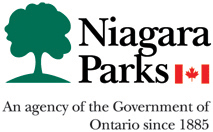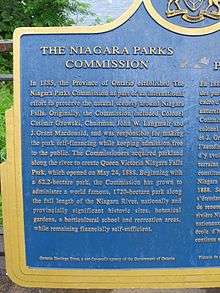Niagara Parks Commission



The Niagara Parks Commission, or Niagara Parks for short, is an agency of government of Ontario which maintains the Ontario shoreline of the Niagara River.
History
The Commission was founded in 1885 and charged with preserving and enhancing the natural beauty of Niagara Falls and the Niagara River corridor as a public greenspace and environmental heritage.[1] The first commissioner was Casimir Gzowski. Other notable Commissioners have included Thomas McQuesten and James Allan. Current Commission Chair is Janice Thomson (2011-present).
Activity
In total, the Commission is in charge of about 16.19 square kilometres (6.25 sq mi) of parkland along the river, in addition to the Niagara Parkway which spans 56 kilometres (35 mi). In this corridor, the NPC manages numerous trails, historic sites, picnic areas, and attractions. These include Journey Behind the Falls, the Niagara Parks Butterfly Conservatory, and the Queenston Floral Clock. The Commission manages Navy Island National Historic Site under a lease agreement with the Parks Canada. It also owns the Chippawa Battlefield Park, and has developed a historical interpretive walk at this War of 1812 site. The NPC runs the Botanical Gardens and since 1997, the Butterfly Conservatory.
NPC operates the Niagara Parks School of Horticulture, a world-renowned training centre for horticulturalists and gardeners.
Other significant properties include the Mackenzie Printery & Newspaper Museum, which holds the nation's oldest press; McFarland House, an 18th Century Georgian home offering tours, tea, wine, and light fare; the Laura Secord Homestead, home to the heroine of the War of 1812, and a National Historic Site; and Old Fort Erie, a War of 1812 site that is claimed to be one of Canada's bloodiest battlefields. In addition, the NPC has placed dozens of green plaques marking significant sites and events along the Niagara River.
Niagara Parks also operated the People Mover, a shuttle bus system intended to aid transportation along the Niagara River and help reduce automobile crowding near the Falls. The buses were powered by propane and included a trailer unit during most popular hours. In the long term, the Commission is planning for a fixed track transit system along the Niagara Parkway, although no decision has been taken on the exact technology to be used.[2][3] In the meantime, the Commission joined forces with Niagara Falls Transit to launch the WEGO bus system in 2012, and in the process discontinued the People Mover service.[4]
NPC now attempts to protect the natural beauty and attract tourism along the Niagara River, Niagara Gorge and Niagara Falls. The NPC is a self-financed agency of the Ontario Ministry of Tourism and Recreation.
Niagara Heritage Trail
The Niagara Heritage Trail is a historic and scenic route running the entire 35 mile Canadian coastline of the Niagara River from Fort Erie northward to Niagara-on-the-Lake. Construction began in stages during the early 1980s, and was completed in 1995.
Along the route, visitors can access the following historical sites:
- Olde Fort Erie, site of a major battle in July, 1814 between British troops stationed there and advancing American troops;
- Chippawa Battlefield Park, site of the first major battle on the Canadian side during the War of 1812, and cited by some historians as the birthplace of the modern American Army;
- Sir Adam Beck Generation Stations near Queenston, twin hydroelectric power plants servicing Ontario and much of the northeastern United States;
- MacKenzie Printery, housing Canada's oldest printing press (ca. 1770) and historical home to William Lyon MacKenzie, a government reformist;
- MacFarland House, which housed wounded British and American soldiers jointly during the War of 1812;
- Laura Secord Homestead, historical home of the woman who set out on a historical walk from Queenston, Ontario to the village of Beaverdams, warning British soldiers of an impending American attack in 1814.
The trail makes its central heart in Queen Victoria Park near the main tourist area, and also passes by attractions such as the Whirlpool Golf Course, Niagara Botanical Gardens, the Butterfly Conservatory, and the Floral clock.
Aims and objectives
The aims and objectives of The Niagara Parks Commission as set out in The R. Strong & Associates Report, 1969, are as follows:
- To maintain, preserve and enhance the beauty and surroundings of the Canadian Horseshoe Falls and the Niagara River, from Fort Erie to Niagara-on-the-Lake, while maintaining financial self-sufficiency;
- To develop, operate and maintain a system of parks and recreation areas, historic sites and educational facilities which complement the natural wonders of Niagara Falls and the Niagara River, and which will facilitate and add to the visitor’s enjoyment;
- To provide those wishing to view and enjoy the splendor of Niagara Falls an opportunity to do so with ease;
- To provide a broad range of educational opportunities in the fields of horticulture, geology, natural history and the history of the Niagara Frontier;
- To continually seek new methods and means for improving the visitor’s experience when visiting the Falls area;
- To encourage complementary uses of land adjacent to the Parks system and to work with other groups and agencies who have compatible interests in the Park area.
- To ensure a suitable first and last impression for the many millions of foreign visitors to Ontario and to Canada crossing the borders along the Niagara Frontier;
- To encourage and promote the development of the tourism industry in Ontario and Canada; and
- To pursue the self-sustaining nature of the Parks System while recognizing the limitations of compatible and suitable revenue-producing facilities and the long-range need for capital improvements.
See also
- List of botanical gardens in Canada
- Alfred H. Savage - Sarnia born horticulturalist and transit manager, School of Horticulture graduate 1952
References
- ↑ "Niagara Parks Attractions". Clifton Hill Resorts. Retrieved 2010-07-23.
- ↑ "People Mover Buses". Niagara Parks Commission. Retrieved March 30, 2007.
- ↑ "The Review - Remember the people mover?". Osprey Media. Retrieved March 30, 2007.
- ↑ Langley, Alison. "New tourism buses stall". Niagara Falls Review. Retrieved 2 May 2013.
External links
- Niagara Parks
- Niagara Parks Act
- The Niagara Parks Commission Collection of Images in the Historic Niagara Digital Collection
- The Niagara Parks School of Horticulture
.svg.png)